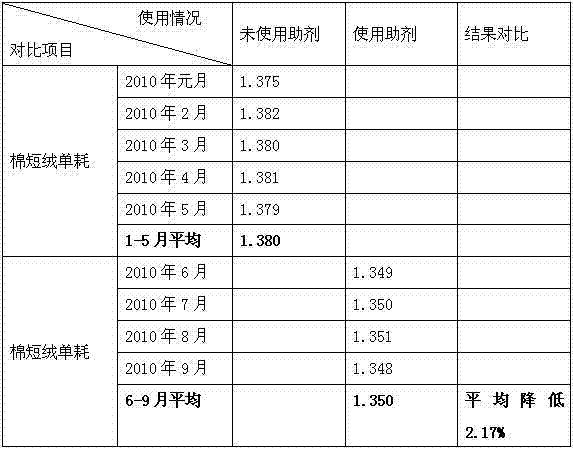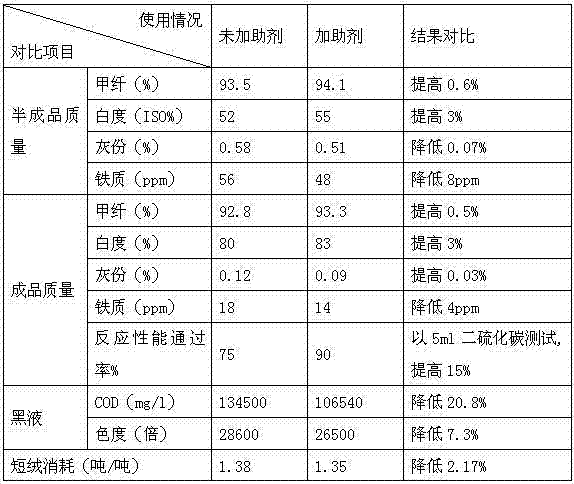Method for preparing chemical fiber pulp
A technology of chemical fiber pulp and additives, which is applied in the fields of pulping of cellulose raw materials, processing of fiber raw materials, textiles and papermaking, etc. It can solve the problems that cooking aids cannot be cooked with chemical fiber pulp and is not environmentally friendly, so as to improve whiteness and driftability, saving resources and reducing the effect of LCC
- Summary
- Abstract
- Description
- Claims
- Application Information
AI Technical Summary
Problems solved by technology
Method used
Image
Examples
Embodiment 1
[0032] A. Cotton opening: Add cotton linters into the cotton opener, after being shredded by large and small licker-in rollers, it is blown into the cyclone separator by air;
[0033] B. Configure environmentally friendly cooking compound additives: weigh sodium sulfite, magnesium sulfate, tetrahydroanthraquinone, sodium dodecylbenzenesulfonate, and ligninase according to the following weight percentages: sodium sulfite 3%, magnesium sulfate 10%, 50% tetrahydroanthraquinone, 30% sodium dodecylbenzenesulfonate, 7% ligninase; uniformly mix solid-phase sodium sulfite, magnesium sulfate, tetrahydroanthraquinone and sodium dodecylbenzenesulfonate to prepare into compound additives;
[0034] C. Configure environment-friendly cooking compound auxiliary liquid: add the compound auxiliary with a weight of 0.3% of the weight of cotton linters into the auxiliary dissolving tank filled with water 4 times the weight of the compound auxiliary, and then add it to step B The weighed ligninas...
Embodiment 2
[0039] A. Cotton opening: Add cotton linters into the cotton opener, after being shredded by large and small licker-in rollers, it is blown into the cyclone separator by air;
[0040] B. Configure environmentally friendly cooking compound additives: weigh sodium sulfite, magnesium sulfate, tetrahydroanthraquinone, sodium dodecylbenzenesulfonate, and ligninase according to the following weight percentages: sodium sulfite 20%, magnesium sulfate 1%, 60% tetrahydroanthraquinone, 15% sodium dodecylbenzenesulfonate, 4% ligninase; uniformly mix solid-phase sodium sulfite, magnesium sulfate, tetrahydroanthraquinone and sodium dodecylbenzenesulfonate to prepare into compound additives;
[0041] C. Configure environment-friendly cooking compound auxiliary liquid: add the compound auxiliary with a weight of 5% of the weight of cotton linters into the auxiliary dissolving tank filled with water 7 times the weight of the compound auxiliary, and then add it to step B The weighed ligninase ...
Embodiment 3
[0046] A. Cotton opening: Add cotton linters into the cotton opener, after being shredded by large and small licker-in rollers, it is blown into the cyclone separator by air;
[0047] B. Configure environmentally friendly cooking compound additives: weigh sodium sulfite, magnesium sulfate, tetrahydroanthraquinone, sodium dodecylbenzenesulfonate, and ligninase according to the following weight percentages: sodium sulfite 20%, magnesium sulfate 10%, 55% tetrahydroanthraquinone, 5% sodium dodecylbenzenesulfonate, 10% ligninase; uniformly mix solid-phase sodium sulfite, magnesium sulfate, tetrahydroanthraquinone, sodium dodecylbenzenesulfonate, and prepare into compound additives;
[0048] C. Configure environment-friendly cooking compound auxiliary liquid: add the compound auxiliary with a weight of 2.7% of the weight of cotton linters into the auxiliary dissolving tank filled with water 5 times the weight of the compound auxiliary, and then add it to step B The weighed ligninas...
PUM
| Property | Measurement | Unit |
|---|---|---|
| viscosity | aaaaa | aaaaa |
| viscosity | aaaaa | aaaaa |
| viscosity | aaaaa | aaaaa |
Abstract
Description
Claims
Application Information
 Login to View More
Login to View More - R&D
- Intellectual Property
- Life Sciences
- Materials
- Tech Scout
- Unparalleled Data Quality
- Higher Quality Content
- 60% Fewer Hallucinations
Browse by: Latest US Patents, China's latest patents, Technical Efficacy Thesaurus, Application Domain, Technology Topic, Popular Technical Reports.
© 2025 PatSnap. All rights reserved.Legal|Privacy policy|Modern Slavery Act Transparency Statement|Sitemap|About US| Contact US: help@patsnap.com



